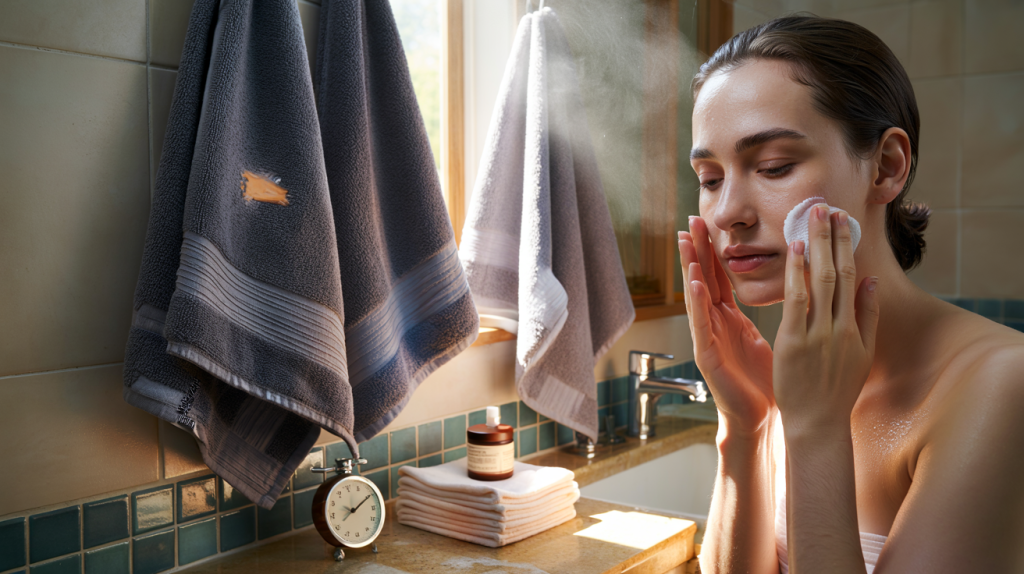Stop rubbing your face the wrong way. See which towel truly supports your skin barrier, how often to wash it, et what to buy to keep breakouts away.
The wrong towel can undo a cleanser and serum in seconds. The right one keeps the skin barrier calm, avoids friction, and helps products sink in without drama.
Dermatology guidance is clear: pat, do not rub, and moisturize fast. The American Academy of Dermatology advises patting dry and applying moisturizer within 3 minutes after cleansing to lock in water in the skin surface (American Academy of Dermatology, updated 2023). Cleanliness matters too, because damp towels can collect microbes between washes. That is the real pivot for your routine.
Best towel for skincare routine: the problem and the quick win
Observation from bathrooms everywhere: thick cotton loops feel luxurious, yet they can pull at skin and leave lint. Microfiber looks simple, but the ultra-fine fibers glide and drink up water fast.
Friction is the problem to solve. Rubbing amplifies redness and can worsen flaking on dry or sensitized skin. Patting with a low-friction towel reduces that daily wear and tear and sets up moisturizer to seal hydration.
So the quick win is tangible: a soft, tightly woven towel that pats water away without tugging, used clean, then moisturizer goes on within the 3-minute window cited by the American Academy of Dermatology in 2023.
Microfiber vs cotton: which protects your skin barrier
Microfiber is not just a buzzword. In healthcare cleaning, microfiber materials removed up to 98 percent of bacteria from surfaces, while conventional cotton mops removed about 30 percent in an Environmental Protection Agency case study in 2002. That data is about rooms, not faces, yet it shows how split microfibers trap particles better than standard cotton loops.
Translation to skincare: microfiber face towels tend to be smoother, creating less friction while wicking water quickly. Cotton can be great too, if the loops are short and the fabric is tightly woven, but very plush terry often rubs.
Texture aside, technique wins. Pat-dry steps, no scrubbing. Then moisturizer goes on promptly to reduce transepidermal water loss, echoing that AAD 3-minute timing in 2023.
Hygiene, acne and laundry: how often to change face towels
Breakouts hate dirty linens. Cleveland Clinic guidance recommends washing a washcloth or face towel after every use and laundering bath towels after about three uses (Cleveland Clinic, 2021). That simple cadence lowers the risk of oil and bacteria re-depositing on skin.
Why the fuss about moisture and time between washes? In the NSF International Household Germ Study, 89 percent of kitchen towels carried coliform bacteria and 14 percent contained E. coli in testing (NSF International, 2011). Different room, same physics: damp fabric becomes a microbe-friendly spot.
Laundry method counts. The Centers for Disease Control et Prevention advises using the warmest appropriate water setting for the fabric and drying items completely to reduce germs on textiles (CDC, 2022). Thorough drying is key. A barely-dry towel sits in the danger zone.
How to choose a face towel: materials, size and care that work
Shopping brings choice overload. Narrow it to what serves your skin and your laundry routine, not just what looks plush on a shelf.
Occasionnally, one small swap unlocks better skin days: a gentle towel plus cleaner habits. Try this simple playbook and keep it going.
- Material : Pick split-fiber microfiber for glide or tightly woven cotton with short loops. Both are gentle when used to pat, not rub.
- Weave and feel : Smooth, low-pile textures create less drag on cheeks and around the eyes.
- Color coding : Choose light colors so makeup or residue shows, then rotate clean towels daily for the face.
- Size : Small face towels or washcloths encourage single-use hygiene. Bigger bath towels usually get reused, which suits the body, not the face.
- Laundry : Wash face towels after each use. Use the warmest setting the label allows and dry fully, echoing CDC advice from 2022.
- Softeners : Skip fabric softener and dryer sheets on towels. Consumer Reports notes softeners reduce absorbency by coating fibers (Consumer Reports, 2017).
- Certification : Look for independent textile labels like OEKO-TEX Standard 100 to limit unwanted chemical residues against the face.
One more everyday fix: hang the towel open on a bar to air-dry fast. Hooks compress fabric and keep moisture trapped against itself, which slows drying and invites odor.
For acne-prone skin, a dedicated face towel used once and washed is often the missing link. That habit lines up with the Cleveland Clinic frequency guidance from 2021 and cuts a quiet, repeated source of grime.
Sensitive skin types often feel better with microfiber’s smoother hand, while oilier skin may prefer a fine-weave cotton that still pats dry cleanly. Either way, the combo that holds up over time is low-friction fabric, single-use for the face, warm water washes, full machine drying, and moisturizer within that 3-minute AAD window in 2023.
